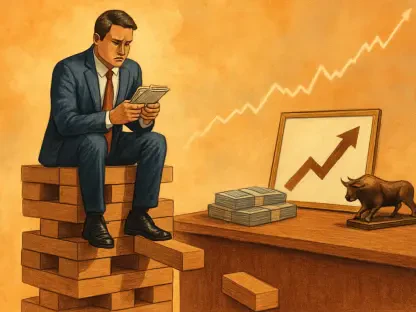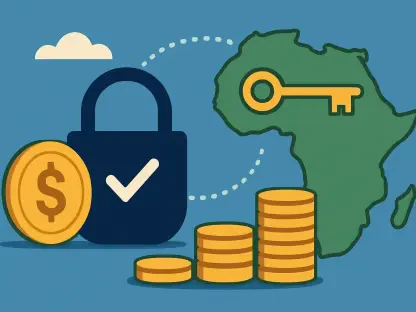The most recent data from S&P Global Market Intelligence has spotlighted a significant trend in the U.S. banking sector: a notable rise in high-volatility commercial real estate (HVCRE) loans. This development brings into focus the dichotomy of market confidence versus the possible hidden risks associated with these types of loans.
Current Landscape of HVCRE Loans
Definition and Purpose of HVCRE Loans
High-volatility commercial real estate loans, or HVCRE loans, are specialized credit facilities used predominantly for the acquisition, development, or construction of real properties. These projects aim to convert properties into income-generating entities that depend on future income, sales, or refinancing for repayment. Given their reliance on future economic performance, HVCRE loans are inherently risky and are closely monitored by financial regulators. These loans generally hold an increased risk profile because they depend on successfully turning the project into a profitable venture, a feat often sensitive to market fluctuations and economic downturns.
This nature of HVCRE loans mandates rigorous oversight from both the lenders and regulators to ensure that the financial systems and banks involved are not overly exposed to potential defaults. Banks offering these loans must maintain a higher capital reserve as a buffer against possible losses, a regulation aimed at mitigating the financial systemic impact should a project fail. Therefore, while these loans present lucrative opportunities for high returns, they also encapsulate an increased level of financial exigency requiring meticulous due diligence and risk assessment from the onset.
Market Trends in 2024
In the second quarter of 2024, U.S. banks witnessed a 20% sequential increase in HVCRE loans, rebounding from a four-year low earlier in the year. The aggregate balance of these loans rose to $34.93 billion from $29.11 billion in Q1. Despite this increase, it represents a slight year-over-year decline from the $36.83 billion recorded in the second quarter of 2023. HVCRE loans made up 0.24% of the sector’s total risk-weighted assets in Q2 2024, reflecting an uptick in their reliance within the broader market landscape.
This notable growth indicates a shifting focus within banks towards lending more to high-risk, high-reward real estate projects. The quarter-over-quarter increase in HVCRE loan balances points toward a revival in the optimism regarding real estate investments, which had tapered off in the recent past owing to economic volatility. These figures not only provide insight into the fluctuating nature of HVCRE loans but also underscore banks’ adaptive strategies in response to evolving market conditions. As lenders navigate this volatile terrain, the current data paints a vivid picture of cautious yet burgeoning optimism in commercial real estate financing.
Analysis of Leading HVCRE Lenders
Morris Bank’s Leading Role
Morris Bank, headquartered in Dublin, Georgia, stands out with an HVCRE loan balance of $265.3 million, which amounted to 19.9% of its risk-weighted assets in Q2 2024. This figure represents the highest ratio among top-tier U.S. banks with at least $1 billion in assets. Morris Bank’s substantial focus on HVCRE loans demonstrates a significant strategic commitment to this sector. The bank’s ability to maintain such a high percentage of HVCRE loans relative to its risk-weighted assets reveals a targeted approach toward capitalizing on real estate financing opportunities despite inherent risks.
This strategic alignment could enhance Morris Bank’s position within the industry, potentially offering higher returns if the underlying real estate projects succeed. However, the high exposure also underscores the bank’s confidence in its risk management practices and market analysis capability. As a relatively smaller player when compared to industry giants, Morris Bank’s maneuver signifies a bold, albeit calculated, risk which could either bolster its portfolio significantly or expose it to magnified risks should the market falter.
Goldman Sachs’ Consistent Performance
Goldman Sachs has maintained its position as the top HVCRE lender for three consecutive quarters. As of June 30, 2024, its HVCRE loan portfolio amounted to $2.09 billion, reflecting a 1.0% quarter-over-quarter growth and 0.3% of its risk-weighted assets. Goldman Sachs’ consistent lending in this space indicates a cautious yet confident approach, contributing to its steady performance in the commercial real estate financing landscape.
The firm’s ability to remain the top HVCRE lender underlines its robust market strategy and risk assessment frameworks, which enable it to navigate the complex dynamics of high-risk real estate investments. Goldman Sachs’ performance amidst an evolving market indicates its strategic flexibility and operational acumen in capital allocation towards HVCRE lending. This adaptability, combined with rigorous risk management protocols, aids in sustaining its dominance in this high-stakes sector, reflecting a blend of prudence and strategic vision in leveraging HVCRE opportunities.
Implications of Rising HVCRE Loans
Market Confidence and Strategic Positioning
The rising volume of HVCRE loans may suggest growing confidence among banks in the resilience of the commercial real estate market. The sequential increase, following a historic low, mirrors a cautious optimism about market demands and economic signals. This resurgence could indicate a strategic positioning ahead of potential future growth in the sector. For banks, this trend serves as a barometer indicating heightened market activity and an optimistic outlook regarding the potential for positive returns on real estate investments.
This market confidence could be driven by improving economic indicators, reduced COVID-19-related disruptions, and a surge in demand for commercial spaces. These factors collectively may inspire banks to lean into the HVCRE sector, anticipating a profitable landscape ahead. However, this surge in loan issuance necessitates vigilance to ensure the bets placed within this volatile market are well-calculated and resilient to economic oscillations that could alter future market dynamics drastically.
Hidden Risks and Regulatory Scrutiny
However, the inherent risks associated with HVCRE loans cannot be overlooked. The dependency on future economic performance, coupled with fluctuating property values and tightening credit conditions, necessitates stringent regulatory scrutiny. Banks must strike a delicate balance between capitalizing on opportunities and adhering to regulations designed to mitigate potential risks. These risks also highlight the importance of thorough due diligence and continuous market analysis to pre-empt possible financial disturbances.
As regulators emphasize stricter oversight, banks must ensure their HVCRE lending practices align with the broader risk management frameworks to safeguard against destabilizing impacts on their financial health. The duality of capturing market opportunities while safeguarding against potential pitfalls underscores the nuanced approach required by banks. This vigilance is pivotal in navigating the interplay between leveraging high-reward scenarios and maintaining regulatory compliance to ensure long-term market stability and profitability.
Future Outlook and Industry Events
Challenges Ahead for the Distressed Property Market
The distressed property market is poised to face significant challenges, particularly with upcoming Commercial Mortgage-Backed Securities (CMBS) maturities and evolving underwriting practices. The rising volume of HVCRE loans might be a strategic move by banks to navigate these impending hurdles effectively. Banks’ inclination towards HVCRE loans could signify preparations for an anticipated increase in demand for refinancing distressed assets as CMBS reach maturity with stricter lending conditions on the horizon.
This proactive stance can offer banks a competitive edge, positioning themselves strategically to address the anticipated market upheavals and leverage new opportunities within the distressed property landscape. By realigning their portfolios towards high-volatility, high-reward loans, banks may attempt to mitigate the impact of these impending market shifts, ensuring they are adequately prepared to manage both the risks and rewards associated with this complex market sector.
Upcoming Industry Event – Connect Distressed Investment & Finance
The latest data from S&P Global Market Intelligence highlights a significant trend in the U.S. banking sector: a notable increase in high-volatility commercial real estate (HVCRE) loans. These HVCRE loans are essentially commercial real estate loans that bear higher risks due to their speculative nature. This uptick in HVCRE loans brings into sharp relief the tension between strong market confidence and the hidden risks inherent in these types of loans. Banks are riding a wave of optimism, prompted by robust economic indicators and property development booms. Yet, beneath this surface lies a potential nightmare scenario: the possibility that these HVCRE loans could default, leading to significant financial instability. Essentially, while the market is currently buoyant, the stability built on such volatile foundations remains precarious. Therefore, it’s vital for both investors and regulators to keep a close eye on the trend and to be prepared for the potential risks associated with the increase in high-volatility commercial real estate loans. The balance between risk and reward in this case is particularly delicate and warrants careful monitoring.









